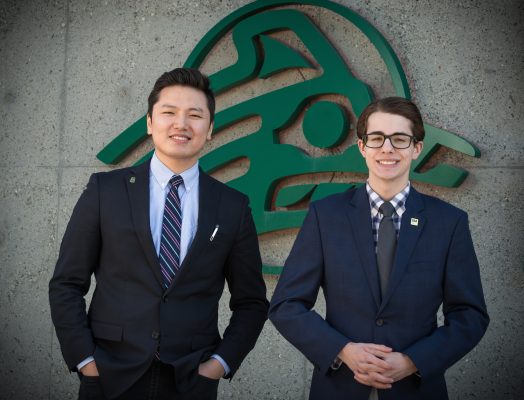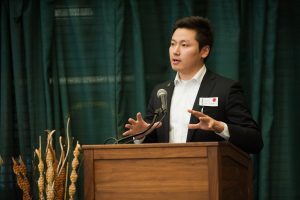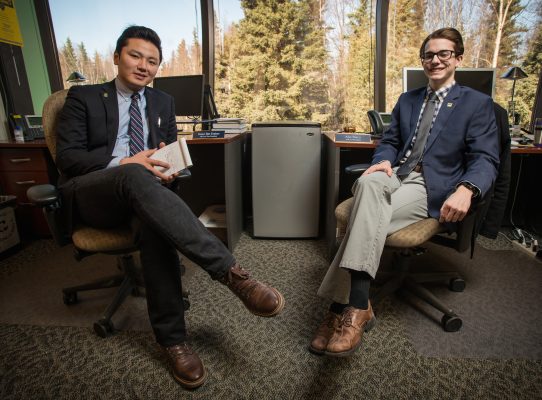A Q&A with USUAA: President and VP talk advocacy, budget and the Juneau fly-in
by joey |

USUAA President Alec Burris, right, and Vice President Geser Bat-Erdene, outside UAA's Student Union. (Photo by James Evans / University of Alaska Anchorage)
From March 17-20, a contingent of eight student leaders flew to Juneau to advocate on behalf of their 16,000 classmates at UAA.
The annual legislative fly-in brings student leaders from every UA campus together at the Alaska State Legislature, where they meet legislators and share stories about the value of investing in public education in Alaska.
USUAA President Alec Burris and Vice President Geser Bat-Erdene recently returned from this year's fly-in. Burris, a sophomore chemistry major from Wasilla, and Bat-Erdene, a senior finance major from Erdenet, Mongolia, shared thoughts on the trip, and their year at the helm of USUAA.
This interview has been edited and condensed.
What was your message to legislators in Juneau?
AB: This year we emphasized three points, the first being the university budget and why it's important that the university is adequately funded. Secondly, we talked about the Alaska Performance Scholarship and Alaska Education Grant, how those programs impact students and what would happen if they were gone. Thirdly, we talked about the Alaska education tax credit, which funds a lot of our vocational programs and buildings. That tax credit was going to sunset in December, and it looks like they're going to renew it for another six years.
When you're advocating alongside student leaders from across Alaska, what sets UAA apart?
AB: I don't think there's one particular issue that sets us apart, but I think we can say we were leading the charge on specific issues. A lot of the things, specifically with the university budget, are going to affect us. We have the most students out of any campus by far, so it's particularly important to us. Any change is going to impact us more than any other campus
What's it like speaking for so many voices in UAA's diverse student population?
AB: It's been very important to us that the student government isn't an insular organization. We speak on behalf of students, but that's not something we do alone. Throughout the year, Geser and I and other members of the assembly regularly attend different student organization meetings to get a feel for what students are thinking, whether that's Club Council, Black Student Union, or other student organizations. We've been going to these organizations to ask what they think and get a better perspective. Additionally, this year we acquired a listserv which goes out to all students who pay the student government fee. That's another way we're getting the full perspective from UAA students.
GB: We wanted to make sure we have transparency between students and different services in the administration, and our public meetings as well. One of the most feasible steps was to increase accessibility to our meetings, so we started live streaming meetings using social media platforms. That increased interest in student government. Speaking of diversity, I myself am an international student. I get a lot of feedback from international students who were encouraged to see they have the same opportunities if they want to assume leadership opportunities.
Any highlights of the year so far?
AB: For me, it's raising student worker pay. Up until this increase [implementing this summer], the lowest level of student worker pay was $1.34 below minimum wage. That was something we felt was absolutely unacceptable. I called other student governments around the state, talked to the Board of Regents and spoke with [UA] President Johnsen. We started an initiative here on our campus, and to see that change while we were still in office was pretty wonderful.
What might students not realize about your role?

Geser Bat-Erdene speaks during Career Networking Night in UAA's Student Union on March 29. (Photo by James Evans / University of Alaska Anchorage)
AB: On average, I have from five to 15 meetings a week with administrators, with student groups, meeting with members of the assembly. If the assembly wants to take on a certain issue, it's really our job to assure that happens.
GB: Our time and commitment is not visible all the time. Our role is to do a lot of background work, and we've been able to address a lot of student concerns. I always hold realistic expectations for things. If there's an issue, let's try to improve it step-by-step. Don't expect overnight changes and let's try and make it happen. A lot of our events are based on that.
What prepared you for this role of advocacy?
GB: I think it's an ongoing role, all the time, and we're still learning. Being involved in student government and taking that step to join this organization is a critical moment if a student wants to advocate for the university.
AB: I think you just have to demonstrate a passion for it. Throw yourself out there and join student government. You can change more things than you think you would.
Why is the USUAA advocacy platform valuable to you?
GB: My experience last year was a defining moment in my personal understanding of why all this matters. The country I came from, we are a relatively young democracy - only 20-some years - and I didn't know that young people, students like us, could actually have one-on-one meetings with decision-makers. That was a defining moment in learning about this, and I feel like I can share those skills with others.
AB: To me, it's important because legislators will listen to students. The legislature isn't going to listen to a university employee the same way. They have a vested interest in the university continuing, because that's who employs them. But if you have students who share their stories about how great this university is, the legislature will look at that through a different light. That's very important. This isn't our employer. We love this university and we want to see it continue
What about UAA do you love?
AB: Other than student government, I think it's how willing this university is to adapt to change. Any individual can come to this university and make a change, and that doesn't mean just students. We're seeing this with our new Vice Chancellor of Student Success Claudia Lampman making changes to our advising structure that students have been asking for. That's just one person making some really big changes.
GB: I've heard feedback that local businesses feel newly graduating students need more interactions and certain courses. The College of Business and Public Policy adapted and came up with new classes. They came up with new minors. That willingness to adapt to changes not only from student perspectives, but also from what the industry requires, makes us attractive.
How do students get in touch with USUAA?
AB: However they want to. We send monthly emails to the entire student body updating them on the work of student government and encouraging them to reach out to us. If someone is in the office, our policy is that the door remains open. We're here to listen to student concerns, and we're always open to that.
USUAA's office is on the top floor of the Student Union. Visit USUAA's website to see an upcoming calendar of assembly meetings and campus events, as well as individual contact information.

USUAA President Alec Burris, right, and Vice President Geser Bat-Erdene, left, in their office in UAA's Student Union. (Photo by James Evans / University of Alaska Anchorage)
 "A Q&A with USUAA: President and VP talk advocacy, budget and the Juneau fly-in" is licensed under a Creative Commons Attribution-NonCommercial 4.0 International License.
"A Q&A with USUAA: President and VP talk advocacy, budget and the Juneau fly-in" is licensed under a Creative Commons Attribution-NonCommercial 4.0 International License.














